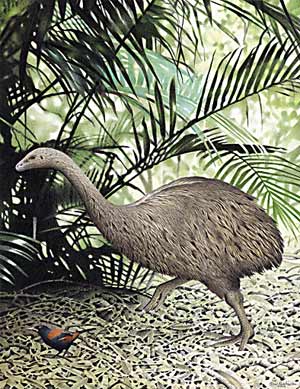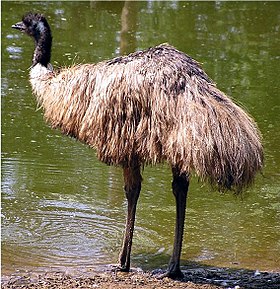
February 9, 2007

A Moa? Please note the darker front part of the body is in shadow and the rear portion – with apparent feathers visible – is to the right, in sunlight.
Is the above a photograph of a living Moa? I interviewed the credible eyewitness and photographer, a former member of the British Army’s elite Special Air Service (SAS). Here’s the backstory.
In 1958, cryptozoologist Bernard Heuvelmans entitled a chapter of his On the Track of Unknown Animals, “The Moa, a Fossil That May Still Thrive.” Moas, both medium-sized and giant forms, have been reported periodically in New Zealand since their supposed extinction 500 years ago. Moas, flightless birds, are related to New Zealand’s kiwis, Australian emus, Australian and New Guinea cassowaries, African ostriches, and South American rheas.

The little blue moa.
Writing in the 1960s, cryptozoologist and zoologist Ivan T. Sanderson took note of continuing — albeit rare — sightings of moas on New Zealand’s South Island.
One of the most recent alleged sightings of a large moa took place on January 20, 1993, in the Craigieburn Range. Three individuals sighted and one of them photographed what they insisted was a six-foot-tall bird. They swore it was a moa, not an emu, ostrich, red deer, or any of the other expert-proposed or media-suggested animal candidates.
Paddy Freaney, current hotel owner and former instructor with the British Army’s elite Special Air Service, and his companions Sam Waby and Rochelle Rafferly were tramping — a New Zealand term for hiking in rugged terrain — in the Canterbury high country when they came upon a large bird. “The minute I saw it, I knew what it was,” Freaney said soon afterwards. “I believe it was a moa.”
It was about a meter off the ground, with a long, thin neck of another meter’s (three feet’s) length, ending in a small head and beak. It was covered in reddish-brown and gray feathers. The large, thick legs were covered with feathers almost to the knee joint, with bare legs below, and huge feet. (Interestingly, in his revised reconstruction of the moa based on descriptions of aboriginal sightings, Heuvelmans broke with the traditional bare-legged, ostrichlike drawings of what moas supposedly looked like and instead showed them with feathers down to their knees. Heuvelmans writes on this point: “There is no evidence that the moa did not have feathered legs like a Cochin hen and like the kiwi itself. Only the fast-running bird of the plains has any advantage in bare legs, and the moa was not one.”)
The large bird ran off across a stream when the witnesses disturbed it. An outdoor survival expert with the SAS, Freaney dashed after the animal and took a photograph of it at a distance of 35 to 40 meters. He also snapped a picture a minute later of what he thought was the bird’s wet footprint on a rock. He also took photographs of similar prints in shingle by the river bed.
The out-of-focus view of the bird has a rock formation obscuring its legs. From what can be seen, the moa appears to be medium brown, with a horizontal body, a tall, erect neck, and a head which may have been looking toward the camera. An image-processing group at the University of Canterbury’s electrical and electronic engineering department spent three days analyzing the blurred photograph.
Speaking on behalf of the group, Kevin Taylor said the analysis had gone as far as it could go, but in his judgment it confirmed that the object was a large bird. On the other hand, Richard Holdaway, a former University of Canterbury postgraduate zoology student and currently a palaeoecologist, stated flatly that the photograph showed a red deer. The neck was too thick for a bird’s, he said, adding, “When you look at it at a distance like that, to me it looks like a poor image of the back end of a red deer going west.”
After the Department of Conservation (DOC) backed away from its announced plan to search the area immediately, Freaney offered to mount an expedition himself, in some respects to clear his name after hoaxes charges circulated. Meantime, one expert’s claim that the sighted bird was an emu was rapidly laid to rest when all captive emus in New Zealand were accounted for by officialdom.

Australian emu (Dromaius novaehollandiae)
But the damage had been done, discouraging the DOC from its launching a serious search. And time was running out for the collection of the verifying evidence. A week after the sighting, Freaney remarked that bad weather in the back country may have already eliminated some of the proofs of the moa, especially the prints in the shingle. “The river will have been in flood and that will wipe out some of the signs. It’s a shame DOC did not manage to investigate the sighting earlier,” he said.
I interviewed Freaney on February 22, 1993, to clarify some points of the report. Freaney said he had turned over the original negative for analysis, but apparently the New Zealand resources for computer enhancement were more limited than initially claimed. The results proved inconclusive. According to Freaney, the bird was definitely larger than any emu he has ever seen in Australia; the feathers looked darker in the shade but basically were light brown most of the time they were in the sun; and the feathers appeared to stop at the knees. He also said no investigator before me had expressed interest in the footprint photos.
Freaney said he soon grew dismayed by various “expert” attempts at debunking the account. These included a newspaperman’s slander about a nonexistent liars club and the related brief fale cllaim by a publicity seeker that the affair was a hoax. Freaney stood by his story, and he remained determined to find a living moa.
Paddy Freaney remarked: “This is a genuine claim…I am not seeking publicity.” Indeed, it was others who were trying to do exactly that. When word came out that the sighting might be a hoax, the person making that claim was tracked down. The jokester quickly retracted what he had said, noting he was merely trying to get publicity for himself and take it away from Freaney.
In discussions I had with Ian Roy, Director of Public Affairs, New Zealand Embassy in Washington D. C., it was rather clear that the New Zealand government was taking this moa incident seriously. Roy informed me he was “receiving daily dispatches on the matter, similar to how your State Department gets dispatches on important events.” He assured me that their analysis of the photograph “definitely shows that it is not a fake, not a cardboard cutout, or anything of that sort.”
When I interviewed Paddy Freaney in February 1993, he confirmed elements of the moa descriptions as given in the press. Freaney pointed out to me that
(1) the bird was definitely larger than any emu he has ever seen in Australia,
(2) the feathers looked darker in the shade, but basically were light brown most of the time they were in the sun,
(3) the feathers appeared to stop at the knees, and
(4) no one but this investigator had expressed any interest in the footprint photos.
Confirmation of the Freaney report surfaced months later when it was discovered two German trekkers in New Zealand had written in a hiking outpost’s logbook that they had seen a moa in the same general region as the earlier reports. German cryptozoologist Ulrich Magin’s found that the two Germans mentioned in the report had been in New Zealand at the time of their reported encounter.
In 1994, Freaney was contacted by a businessman on the North Island who was going to financially commit to an intensive, full-scale search for the moa. Freaney remained determined to find a living moa, and through the mid-1990s organized several mini-expeditions in an attempt to capture a live specimen (without a repeat of his chance encounter.)
Do moas still exist in New Zealand? Is one pictured above?
About Loren Coleman
Loren Coleman is one of the world’s leading cryptozoologists, some say “the” leading living cryptozoologist. Certainly, he is acknowledged as the current living American researcher and writer who has most popularized cryptozoology in the late 20th and early 21st centuries.
Starting his fieldwork and investigations in 1960, after traveling and trekking extensively in pursuit of cryptozoological mysteries, Coleman began writing to share his experiences in 1969. An honorary member of Ivan T. Sanderson’s Society for the Investigation of the Unexplained in the 1970s, Coleman has been bestowed with similar honorary memberships of the North Idaho College Cryptozoology Club in 1983, and in subsequent years, that of the British Columbia Scientific Cryptozoology Club, CryptoSafari International, and other international organizations. He was also a Life Member and Benefactor of the International Society of Cryptozoology (now-defunct).
Loren Coleman’s daily blog, as a member of the Cryptomundo Team, served as an ongoing avenue of communication for the ever-growing body of cryptozoo news from 2005 through 2013. He returned as an infrequent contributor beginning Halloween week of 2015.
Coleman is the founder in 2003, and current director of the International Cryptozoology Museum in Portland, Maine.
Filed under CryptoZoo News, Cryptozoology, Expedition Reports, Extinct, Eyewitness Accounts, Forensic Science